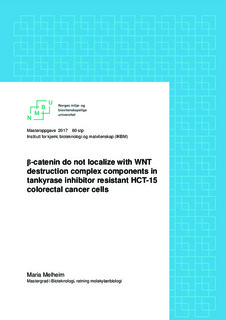| dc.contributor.advisor | Solberg, Nina Therese | |
| dc.contributor.advisor | Krauss, Stefan | |
| dc.contributor.advisor | Lea, Tor Erling | |
| dc.contributor.author | Melheim, Maria | |
| dc.date.accessioned | 2017-09-12T12:49:11Z | |
| dc.date.available | 2017-09-12T12:49:11Z | |
| dc.date.issued | 2017 | |
| dc.identifier.uri | http://hdl.handle.net/11250/2454315 | |
| dc.description.abstract | Blant kaskader og signalveier i cellene har feil i WNT signalveien vist å ha stor betydning i kreftutvikling. I friske celler bytter signalveien på å være aktiv og inaktiv og regulerer på denne måten ulike systemer i cellene. Når mutasjoner oppstår medfører dette uttrykk av konstant aktiv WNT signalering. Tankyrase har vist seg å være et WNT signalaktiveringsprotein, og fungerer ved å markere AXIN1/2 for degradering. Ved å hemme tankyrase vil AXIN1/2 blir stabilisert og β-catenin proteinnivå vil synke med en følgende reduksjon av proliferasjon.
Tarmkreft cellelinjen COLO 320DM har vist seg å være sensitiv mot tankyrase hemming hvor β-catenin blir merket for degradering av destruksjonskomplekset, men ikke alle tarmkreft cellelinjer er sensitive mot tankyrase hemming. Et eksempel på en resistent tarmkreft cellelinje er HCT-15. Målet med denne oppgaven er derfor å undersøke om β-catenin er lokalisert med WNT destruksjonskomplekskomponentene i HCT-15 celler, eller om separerte grupper av WNT destruksjonskomlekskomponenter holder β-catenin vekk fra komplekset, som av den grunn unngår å bli degradert.
Analyser bekreftet kolokalisering mellom TNKS1/2, GSK3β og AXIN2 i cytoplasmamembranen i HCT-15 celler behandlet med tankyrase hemmende behandling, men β-catenin var ikke i disse kompleksene. Med MEK hemmende behandling ble både β-catenin og TNKS-kompleksene frigjort fra cytoplasmamembranen, og det ble observert sterk reduksjon i proliferasjonsraten.
Likevel ble ikke β-catenin observert i TNKS-kompleksene, i tillegg til at protein nivået av β-catenin var upåvirket. Dette beviste at det er β-catenin uavhengig proliferasjon i HCT-15 celler, som igjen ble bekreftet ved esiRNA mediert fjerning av β-catenin. Hvilke mekanismer som kontrollerer proliferasjonen i HCT-15 celler er ikke fullstendig forstått, men resultatene i denne oppgaven gir en indikasjon på at EGFR signalveien og AXIN1/2 er involvert. | nb_NO |
| dc.description.abstract | Among the cascades and signaling pathways inside the cells, defects found in the WNT/β-catenin signaling pathway play a significant role in human cancer. The WNT/β-catenin signaling pathway switches between an “on” and “off” state, however in cancer, mutations creates a constitutive active signaling. Over the last years researchers have drawn attention towards a poly-ADP ribose polymerase called tankyrase, which are found to activate the WNT/β-catenin signaling pathway through degradation of AXIN1/2 proteins. By inhibiting tankyrase, stabilization of AXIN1/2 decreases β-catenin protein levels with subsequent reduction in proliferation of many colorectal cancer cell lines.
The COLO 320DM colorectal cancer cell line has shown to be sensitive to tankyrase inhibition (TNKSi), where β-catenin is subsequently targeted for degradation by the destruction complex. However, there are several colorectal cancer cell lines that are insensitive to TNKSi, where neither β-catenin nor proliferation is affected. The HCT- 15 colorectal cancer cell line is one such TNKSi resistant cell line. The aim of this thesis was therefore to investigate whether β-catenin is localized with WNT destruction complex components in HCT-15 cells, or whether separate pools of destruction complex components protect β-catenin from degradation.
Analysis confirmed co-localization between TNKS1/2, GSK3β and AXIN2 in the cytoplasmic membrane upon TNKSi in HCT-15 cells. However, β-catenin was not under any tested condition co-localized with the destruction complex. Upon inhibition of MEK, a release of both TNKS1/2 containing complexes and β-catenin from the cell membrane occurred, with subsequent strong reduction in proliferation rate. However, β-catenin did not co-localize with the TNKS1/2 containing complexes. β-catenin protein levels were not affected by the MEKi, confirming a β-catenin independent proliferation, which was also confirmed by knock down of β-catenin. Which mechanisms controlling proliferation rate of HCT-15 cells are not fully understood, however results indicate that the EGFR-pathway and AXIN1/2 are involved. | nb_NO |
| dc.language.iso | eng | nb_NO |
| dc.publisher | Norwegian University of Life Sciences, Ås | nb_NO |
| dc.rights | Attribution-NonCommercial-NoDerivatives 4.0 Internasjonal | * |
| dc.rights.uri | http://creativecommons.org/licenses/by-nc-nd/4.0/deed.no | * |
| dc.title | β-catenin do not localize with WNT destruction complex components in tankyrase inhibitor resistant HCT-15 colorectal cancer cells | nb_NO |
| dc.type | Master thesis | nb_NO |
| dc.description.version | submittedVersion | nb_NO |
| dc.source.pagenumber | 71 | nb_NO |
| dc.description.localcode | M-BIOTEK | nb_NO |

